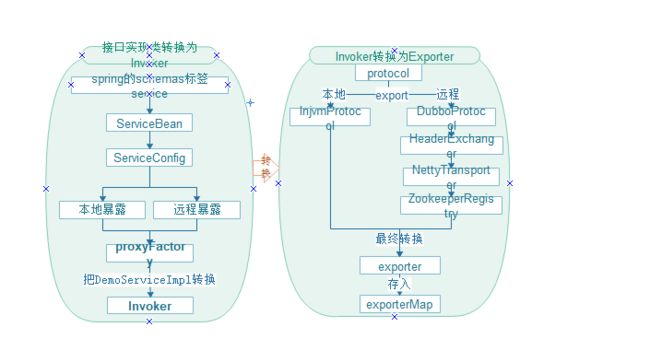dubbo源码分析(二):dubbo服务暴露总过程
dubbo服务的暴露过程主要是分为两步:
- 将provider的接口实现类转化为Invoker对象
- 将Invoker对象转化为Exporter对象
dubbo服务暴露总过程
ServiceBean
public void onApplicationEvent(ApplicationEvent event) {
if (ContextRefreshedEvent.class.getName().equals(event.getClass().getName())) {
if (isDelay() && !isExported() && !isUnexported()) {
if (logger.isInfoEnabled()) {
logger.info("The service ready on spring started. service: " + getInterface());
}
export();//对服务进行暴露开始
}
}
}
ServiceConfig
public synchronized void export() {
if (provider != null) {
if (export == null) {
export = provider.getExport();
}
if (delay == null) {
delay = provider.getDelay();
}
}
if (export != null && !export.booleanValue()) {
return;
}
if (delay != null && delay > 0) {
Thread thread = new Thread(new Runnable() {
public void run() {
try {
Thread.sleep(delay);
} catch (Throwable e) {
}
doExport();
}
});
thread.setDaemon(true);
thread.setName("DelayExportServiceThread");
thread.start();
} else {
doExport(); //继续暴露
}
}
protected synchronized void doExport() {
if (unexported) {
throw new IllegalStateException("Already unexported!");
}
if (exported) {
return;
}
exported = true;
if (interfaceName == null || interfaceName.length() == 0) {
throw new IllegalStateException(" @SuppressWarnings({"unchecked", "rawtypes"})
private void doExportUrls() {
List registryURLs = loadRegistries(true);//从dubbo.properties里面组装registry的url信息
for (ProtocolConfig protocolConfig : protocols) {
doExportUrlsFor1Protocol(protocolConfig, registryURLs);//继续暴露
}
}
下面我们来看doExportUrlsFor1Protocol(protocolConfig, registryURLs)
因为这个方法比较复杂,故而先只贴出比较重要的那部分代码
private void doExportUrlsFor1Protocol(ProtocolConfig protocolConfig, List registryURLs) {
...
//省略一部分代码
String scope = url.getParameter(Constants.SCOPE_KEY);
//配置为none不暴露
if (!Constants.SCOPE_NONE.toString().equalsIgnoreCase(scope)) {
//配置不是remote的情况下做本地暴露 (配置为remote,则表示只暴露远程服务)
if (!Constants.SCOPE_REMOTE.toString().equalsIgnoreCase(scope)) {
exportLocal(url);
}
//如果配置不是local则暴露为远程服务.(配置为local,则表示只暴露本地服务)
if (!Constants.SCOPE_LOCAL.toString().equalsIgnoreCase(scope)) {
if (logger.isInfoEnabled()) {
logger.info("Export dubbo service " + interfaceClass.getName() + " to url " + url);
}
if (registryURLs != null && registryURLs.size() > 0
&& url.getParameter("register", true)) {
for (URL registryURL : registryURLs) {
url = url.addParameterIfAbsent("dynamic", registryURL.getParameter("dynamic"));
URL monitorUrl = loadMonitor(registryURL);
if (monitorUrl != null) {
url = url.addParameterAndEncoded(Constants.MONITOR_KEY, monitorUrl.toFullString());
}
if (logger.isInfoEnabled()) {
logger.info("Register dubbo service " + interfaceClass.getName() + " url " + url + " to registry " + registryURL);
}
Invoker invoker = proxyFactory.getInvoker(ref, (Class) interfaceClass, registryURL.addParameterAndEncoded(Constants.EXPORT_KEY, url.toFullString()));
Exporter exporter = protocol.export(invoker);
exporters.add(exporter);
}
} else {
Invoker invoker = proxyFactory.getInvoker(ref, (Class) interfaceClass, url);
Exporter exporter = protocol.export(invoker);
exporters.add(exporter);
}
}
}
this.urls.add(url);
}
这里会进行两次服务的暴露
- 暴露本地暴露:指暴露在用一个JVM里面,不用通过调用zk来进行远程通信。例如:在同一个服务,自己调用自己的接口,就没必要进行网络IP连接来通信。
- 暴露远程服务:指暴露给远程客户端的IP和端口号,通过网络来实现通信。
该方法中 exportLocal(url) 是用来进行本地暴露,
下面这部分代码是用来做远程暴露
Invoker invoker = proxyFactory.getInvoker(ref, (Class) interfaceClass, registryURL.addParameterAndEncoded(Constants.EXPORT_KEY, url.toFullString()));
Exporter exporter = protocol.export(invoker);

